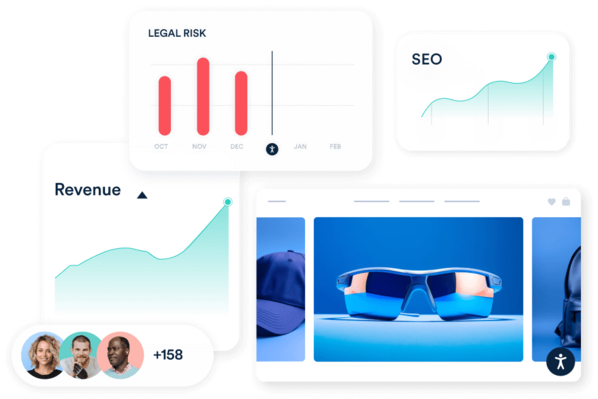Unlocking the Power of Website Accessibility.
A Guide to Inclusive Web Design for ALL Australians

Unlocking the Power of Website Accessibility. A Guide to Inclusive Web Design for ALL Australians
In today’s digital world, creating a website that is accessible to everyone is no longer optional—it’s a necessity.
With 20% of Australians living with disabilities and an increasingly diverse online population, prioritising accessibility is a critical step in ensuring that all users can access and interact with digital content effectively.
This guide explores the key principles, challenges, and strategies of accessible web design, offering actionable advice to help businesses meet compliance requirements and foster a more inclusive digital experience.
Understanding Website Accessibility
Website accessibility involves designing and developing websites so that all users, regardless of their abilities or disabilities, can navigate, understand, and interact with them.
This includes users with visual, auditory, motor, or cognitive impairments. But accessibility doesn’t stop there—it also benefits older adults, users with temporary injuries, and those in challenging environments, such as low internet connectivity or noisy spaces.
By incorporating accessibility into every stage of web design, businesses not only comply with legal standards but also create a more equitable and enjoyable digital experience for everyone.
For example, users with visual impairments may rely on screen readers to convert text into audio or braille, while users with hearing impairments benefit from captions on videos.
Recognising and addressing these needs ensures a more inclusive online environment.
Why Inclusive Web Design is Critical
When websites are designed without accessibility in mind, they exclude significant portions of the population.
For users with disabilities, this exclusion can result in frustration and a lack of access to essential information and services.
By adopting inclusive web design, businesses can:
Expand Their Audience - Accessible websites can reach more people, including the 20% of Australians living with a disability.
Improve User Experience - Features like clear navigation, readable fonts, and alternative text for images benefit all users, creating a smoother and more enjoyable experience.
Boost SEO - Accessibility improvements, such as using alt text and proper heading structures, can enhance a website’s search engine ranking.
Avoid Legal Risks - In Australia, the Disability Discrimination Act mandates equal access to digital services. Non-compliance can result in legal consequences and damage to an organisation’s reputation.
Common Barriers to Website Accessibility
Despite growing awareness, many websites still contain barriers that limit access.
Key challenges include:
Improper Use of HTML- Without proper semantic HTML, screen readers cannot interpret content correctly, leading to confusion for visually impaired users.
Multimedia Without Accessibility Features - Images without alt text or videos without captions create significant obstacles for users who rely on these features.
Low Contrast and Small Text - Poor colour contrast and tiny fonts can be difficult to read for users with visual or cognitive impairments.
Addressing these barriers requires a proactive approach, including the use of accessibility testing tools and regular audits.
The Role of WCAG - Web Content Accessibility Guidelines
The Web Content Accessibility Guidelines (WCAG), developed by the World Wide Web Consortium (W3C), provide a comprehensive framework for creating accessible digital content.
WCAG is structured around four key principles, known as POUR:
Perceivable - Content must be presented in ways that users can perceive, whether through sight, sound, or touch. For example, images should have descriptive alt text, and videos should include captions.
Operable - Users must be able to navigate and interact with the website easily, using different input methods such as keyboards and screen readers.
Understandable - Information should be presented clearly and consistently, using simple language and logical navigation structures.
Robust - Content should be compatible with various devices and assistive technologies, ensuring that users have a consistent experience.
WCAG standards are organised into three levels of conformance: A (basic), AA (mid-level), and AAA (highest level). Most organisations aim for AA compliance to meet legal requirements and user needs.
Implementing Accessibility: Key Features to Include
Ensuring your website is accessible involves integrating several key features:
Alt Text for Images - Provide descriptive text for images to help screen readers convey their meaning to visually impaired users.
Keyboard Navigation - Ensure that users can navigate all interactive elements using only a keyboard.
Captioning and Transcripts - Provide captions for videos and transcripts for audio content to support users with hearing impairments.
Adjustable Font Sizes and Contrast - Allow users to customise text size and contrast settings for improved readability.
Responsive Design - Ensure the website adapts seamlessly to different screen sizes and devices.
The Benefits of Accessibility for Businesses
Adopting inclusive web design offers several benefits:
Increased Market Reach - By making your website accessible, you can tap into a broader audience, including users with disabilities and older adults.
Enhanced User Satisfaction - Accessible websites provide a better overall experience, encouraging users to stay longer, return more frequently, and recommend your services.
Stronger SEO Performance - Accessibility features like alt text and proper HTML structure can improve your search engine rankings.
Legal Compliance - Meeting accessibility standards helps businesses avoid legal issues under the Disability Discrimination Act.
Tools and Resources for Accessibility Testing
Several tools can help identify and address accessibility issues:
WAVE (Web Accessibility Evaluation Tool) - Offers visual feedback on web pages and highlights accessibility barriers.
axe Accessibility Testing - Integrates with browsers to provide real-time feedback during development.
Looking Ahead: WCAG 3 and the Future of Accessibility
As accessibility needs evolve, so do the standards. The upcoming WCAG 3 aims to be more flexible, covering a broader range of user needs, including those with cognitive disabilities.
It introduces a new conformance model, making it easier for organisations to demonstrate progress and compliance.
By staying informed and adapting to these changes, businesses can continue creating inclusive and accessible digital experiences.
Conclusion: Building an Inclusive Digital Future
Website accessibility is more than a legal requirement—it’s a commitment to ensuring that everyone, regardless of their abilities, can participate in the digital world.
By following WCAG guidelines and adopting inclusive design principles, businesses can create websites that not only comply with standards but also foster meaningful connections with diverse audiences.
IncluD is here to guide you every step of the way. With our comprehensive accessibility platform and expert consulting services, you can build a more inclusive digital future for all Australians.
Start your accessibility journey today with IncluD.
Let's discuss who we can help.

